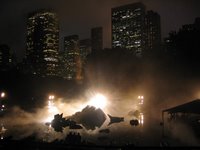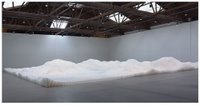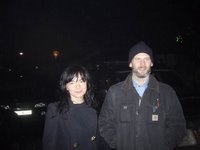
West 27th Street between 11th and 12th Avenues is a quiet, cobblestone street, free of the glossy commercial storefronts and strip clubs that have made surrounding blocks a major destination. Walking west, into the setting sun, it was easy to imagine the street in another era, warehouses and loading docks in full operation. The galleries here, situated only on the north side of the street, are smaller and more intimate, and have been here for only a few months. I visited three on Thursday evening - Plus Ultra Gallery (No. 637), Wallspace (No. 619), and Foxy Production (No. 617).
Plus Ultra Gallery is presenting an exhibition of miniature sculptures by Joe Fig, who portrays well-known artists in their studios. The exhibition’s centerpiece is a detailed replica of the Long Island studios of married artists Eric Fischl and April Gornik, filled with works in progress. Also on view are tiny recreations of contemporary artists’ painting tables, covered with their materials and tools. Beyond the marvel of such scrupulous reproductions, and their whiff of compulsion, is the question of why a young artist would undertake such a documentary-like project. The sculptures certainly form a record (they incorporate taped interviews with the artists), even a voyeuristic one, and they seem to be an homage; an older artist executing a similar project might come off as disgruntled.
Helen Verhoeven’s lush paintings at Wallspace reminded me of Edvard Munch, or perhaps he’s just very much on the mind these days. Born in the Netherlands, Verhoeven seems to tread the same psychological territory; her depictions of figures and interiors have a creepy quality, even when the subject seems banal. They seem remembered instead of observed, as if through the filter of a bad dream.
Michael Bell-Smith, at Foxy Production, is the first artist I’ve seen who convincingly uses digital imagery to examine and comment on its role in contemporary culture. And guess what: He has a blog!














